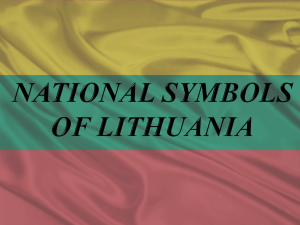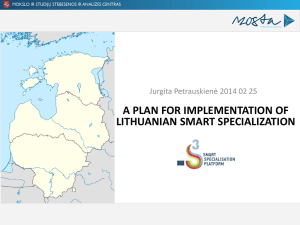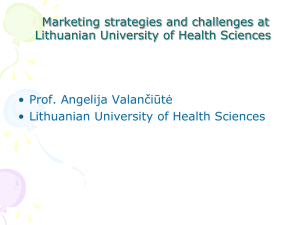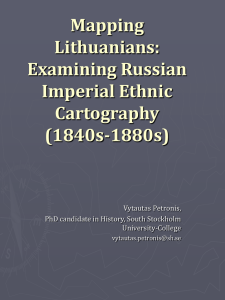Acta Linguistica Lithuanica LXXII (2015) SANTRAUKOS
advertisement
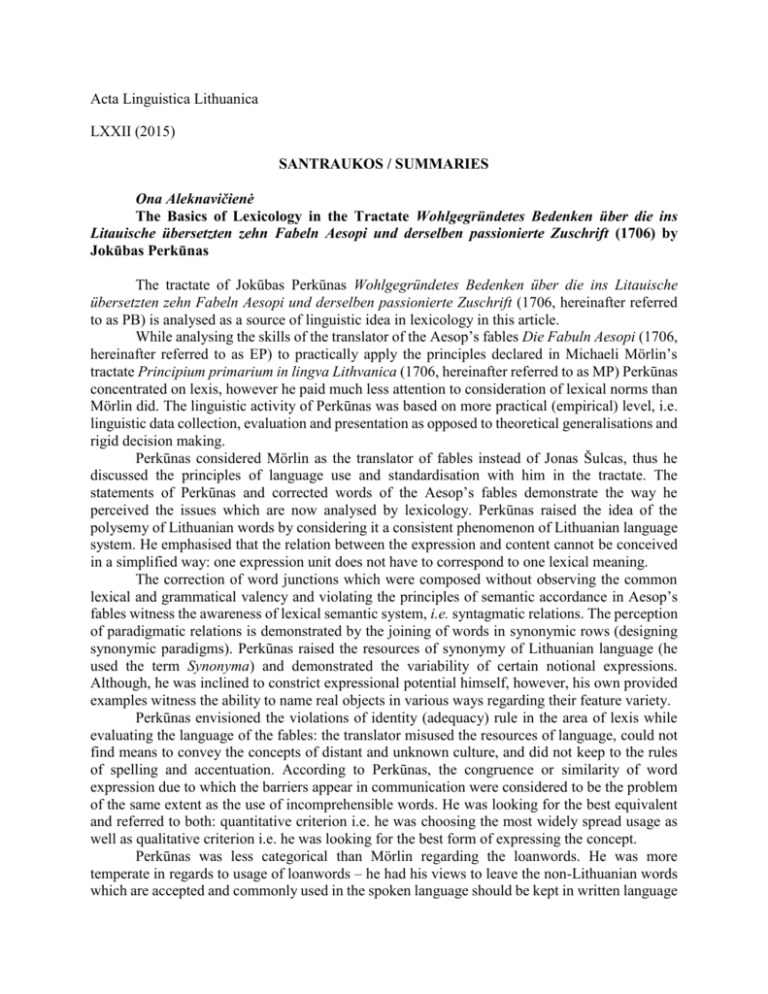
Acta Linguistica Lithuanica LXXII (2015) SANTRAUKOS / SUMMARIES Ona Aleknavičienė The Basics of Lexicology in the Tractate Wohlgegründetes Bedenken über die ins Litauische übersetzten zehn Fabeln Aesopi und derselben passionierte Zuschrift (1706) by Jokūbas Perkūnas The tractate of Jokūbas Perkūnas Wohlgegründetes Bedenken über die ins Litauische übersetzten zehn Fabeln Aesopi und derselben passionierte Zuschrift (1706, hereinafter referred to as PB) is analysed as a source of linguistic idea in lexicology in this article. While analysing the skills of the translator of the Aesop’s fables Die Fabuln Aesopi (1706, hereinafter referred to as EP) to practically apply the principles declared in Michaeli Mörlin’s tractate Principium primarium in lingva Lithvanica (1706, hereinafter referred to as MP) Perkūnas concentrated on lexis, however he paid much less attention to consideration of lexical norms than Mörlin did. The linguistic activity of Perkūnas was based on more practical (empirical) level, i.e. linguistic data collection, evaluation and presentation as opposed to theoretical generalisations and rigid decision making. Perkūnas considered Mörlin as the translator of fables instead of Jonas Šulcas, thus he discussed the principles of language use and standardisation with him in the tractate. The statements of Perkūnas and corrected words of the Aesop’s fables demonstrate the way he perceived the issues which are now analysed by lexicology. Perkūnas raised the idea of the polysemy of Lithuanian words by considering it a consistent phenomenon of Lithuanian language system. He emphasised that the relation between the expression and content cannot be conceived in a simplified way: one expression unit does not have to correspond to one lexical meaning. The correction of word junctions which were composed without observing the common lexical and grammatical valency and violating the principles of semantic accordance in Aesop’s fables witness the awareness of lexical semantic system, i.e. syntagmatic relations. The perception of paradigmatic relations is demonstrated by the joining of words in synonymic rows (designing synonymic paradigms). Perkūnas raised the resources of synonymy of Lithuanian language (he used the term Synonyma) and demonstrated the variability of certain notional expressions. Although, he was inclined to constrict expressional potential himself, however, his own provided examples witness the ability to name real objects in various ways regarding their feature variety. Perkūnas envisioned the violations of identity (adequacy) rule in the area of lexis while evaluating the language of the fables: the translator misused the resources of language, could not find means to convey the concepts of distant and unknown culture, and did not keep to the rules of spelling and accentuation. According to Perkūnas, the congruence or similarity of word expression due to which the barriers appear in communication were considered to be the problem of the same extent as the use of incomprehensible words. He was looking for the best equivalent and referred to both: quantitative criterion i.e. he was choosing the most widely spread usage as well as qualitative criterion i.e. he was looking for the best form of expressing the concept. Perkūnas was less categorical than Mörlin regarding the loanwords. He was more temperate in regards to usage of loanwords – he had his views to leave the non-Lithuanian words which are accepted and commonly used in the spoken language should be kept in written language as well. The reproaches to the translator regarding the abundant use of loanwords are based on the discrepancy between the theoretical requirements of Mörlin and language realisation in the translation of the fables. Perkūnas, as well as Mörlin, distinguished the stable collocations which carry information about unique human understanding of reality objects; the term they used idiotismus can have dual meaning: it can mean “distinctive phrase” or “conventional usage”. Perkūnas, opposite to Mörlin, did not require strict distinction between borrowed phraseologisms and native words. The terminology and statements used by Perkūnas predict the rudiments of lexicology and lead to a conclusion that the philological discussion induced the development of linguistic thought at a rather early stage in this area of linguistic science. Aldonas Pupkis About the Relationship of Juozas Balčikonis and Jan Otrębski The article argues that the communication between Juozas Balčikonis and Jan Otrębski could begin in the late 1930s. Afterwards, their communication evolved into a deep friendship, even camaraderie, of the two linguists. Otrębski considered the compilation of the great “Dictionary of the Lithuanian Language” Balčikonis’ principal work; he supported its type and composition and expressed his positive feedback on volumes I and II of the dictionary in the press. What is more, when speaking about Balčikonis, Otrębski evaluated his translation works, the published writings of Jonas Jablonskis in a highly positive way and indicated that the way of development of the standard language chosen by Jablonskis and Balčikonis was the only right way in the history of the Lithuanian language and the nation. It is the development of a single dialect, continuous reference to the treasuries of dialects and the maintenance of a close relationship with the folk language. Balčikonis was probably the only in Lithuania to spread the word on Otrębski’s works in the broadest way. He wrote about Otrębski’s principal works on Lithuanian linguistics in the press, highlighting that the studies on Lithuanian linguistics are a highly valuable field of his research work. “The Grammar of the Lithuanian Language” translated by Balčikonis is considered a sign of a strong friendship. It is a good occasion to remind that no other anniversaries should be waited for and Balčikonis’ Lithuanian translation should be published without delay. Otrębski’s grammar has not become outdated to this day: it is still a rich source of rare facts of the Lithuanian language; it is noteworthy for numerous original interpretations of the phenomena of the Lithuanian language. Laimutė Balode The Rudiments of New Tendencies in Latvian Onomastics The last congresses of ICOS (International Council of Onomastic Sciences) held in Toronto (2008), Barcelona (2011) and Glazgow (2014) verified that new branches of the research of onyms are becoming more and more popular. The aim of this article is to introduce the latest socio-onomastic studies carried out at the University of Latvia. Several MA and PhD research works in Latvian modern anthroponymics and toponymics carried out by the students of the Faculty of Humanities on the basis of questionnaires are briefly presented in this article. For instance, the overview of the study on the choice of the newborn’s name, parents’ motivation and the main criteria in choosing a name: euphony of the name, originality of the name, harmony between the name and the surname, etc. (Rudzīte 2012, Madžule 2014). Absolute majority of the respondents replied that they are satisfied with their name; Jānis and Līga are mentioned as the nicest Latvian names. It is rather common for families to harmonise the names of sisters and brothers by initials, for example Kristaps and Kristīne, Dina and Dita, or by semantics, for instance Gundega and Madara (both names of the flowers). A comparison of the names of children, parents and grandparents leads to the conclusion that nowadays the names inherited from ancestors are rather rare. It is increasingly popular to choose very rare names for newborns. I. Plēsuma (2012, 2014) studied rare (only once registered) personal names in Latvia as well as the newest trends and tendencies in Latvian first name formation. In the field of toponymy an interesting study on informal urbanonymy was carried out (Donina 2013): about 700 slang urbanonyms from five cities of Latvia located in different ethnographical regions were collected and analysed. The questionnaire helped to find out the motivation of their formation, the ways of derivation (mostly abbreviations or acronyms, also suffix -ene, -ītis, -iņš derivatives as well as metaphors). The most popular slang ergonym among respondents is Hesītis (= fast food restaurant Hesburger); the largest number of variants was recorded in naming the fast food restaurant McDonald’s – Maķis // Maķīts // Maķītis // Mačītis // Mahītis // Makijs // Maķiks // Makčiks // Makdaks. This study also showed the young people’s attitude regarding unofficial place names. Ergonymics is yet another rather new and untouched area of onomastics in Baltic languages. Some interesting research works (Laugale 2009, Bušs 2012, Balode, Bušs 2014) were carried out in Latvia. For example, the employees of various companies of Latvia were interviewed about the origin and motivation of their company’s name (Tīlika 2012). The study of the names of commercial products (or economonyms) has also been initiated. For instance, O. Bušs (2013) compared economonyms of the country with the nation’s mentality. The usage of eponyms (appellatives that originated from onyms – anthroponyms or toponyms) is a new, almost unstudied field in the Baltic countries. The Dictionary of Eponyms (2007), compiled by B. Bankava, has been recently published. She has also defended her PhD dissertation (2011) entitled Eponyms in Latvian: Linguistic Aspect. Although the etymology, semantics and derivation of onyms remain the primary issues that constitute the basis of onomastic research, new branches of onomastics are already on the way. Anta Trumpa Place-names with the Component sāt- in the Dictionary of Latvian Toponyms “Dictionary of Latvian Toponyms” (Latvijas vietvārdu vārdnīca) is a rich source of materials for the researchers of Latvian place-names. It contains data from the card files of Latvian toponyms gathered during earlier times, archival materials, toponym dictionaries published during different periods of time, etc. Volume S1, which is still in progress, contains an extensive entry devoted to the component „Sāt”, covering almost 7 pages. Latvian dialectal word sāts / sāta / sāte (‘house, home’), as well as its semantics, etymology and reflection in place-names, has been discussed by Latvian linguists for almost a century. The opinions about its origins have been varied – J. Endzelīns and K. Abens believed that it might be a borrowing from Estonian or Livonian, while most other researchers agreed with J. Plāķis stating that it is an Indo-European word. The materials included in the “Dictionary of Latvian Toponyms” confirm the earlier knowledge that toponyms with sāt- are mostly used in Kurzeme and, more precisely, in the territory of the Curonian language substratum. In most cases, sāt- is observed in microtoponyms (names of meadows, fields and forests), but there is also a considerably large group of oikonyms (names of farmhouses, manors and rural territories). In the eastern part of the area, the root sāt- mainly survives in oikonyms, thus confirming the fact that microtoponyms are likely to disappear first when the respective apellative is no longer used. Obviously, the usage of the apellative sāts began to diminish. Summing up the opinions of linguists and the data from the dictionary of toponyms, the article presents the following conclusions: 1) place-names with the root sāt- in Latvia tend to diminish, especially in microtoponyms, 2) the dialectal noun sāts / sāta / sāte used to be more widespread in the past, but its usage has gradually shrunk, leaving some traces in oikonyms; 3) sāts / sāta / sāte does not seem to have Finno-Ugric origin; it is most probably an archaic Indo-European word whose traces can be observed in the territory formerly inhabited by the Curonians in Latvia, and also some parts of Lithuania. Aurelija Gritėnienė Folk and Dialectal Names of the Genera of Plants in Contemporary Lithuanian Prose Following a thorough reading of nearly 100 works of prose of 21st century Lithuanian authors, 203 names of plants which are in some way (by their root, meaning, formation or phonetic composition) different from scientific names of plants were found in 80 works of 49 authors. The main aim of research was to identify what folk and dialectal one-word names of the genera of plants appear in contemporary Lithuanian prose, to analyse their structure, origin and prevalence and to discuss the functions and context of their use in the texts of fiction. In terms of origin, various names of plants borrowed from foreign languages and widely used by Lithuanian authors of prose make up a rather numerous group. The majority of them (17 names) have a Latin root but they came to the Lithuanian language through other (usually Slavic or German) languages. 19 loanwords derive from Slavic languages. 9 names of plants are considered hybrids. In respect of prevalence, the names of plants recorded in prose texts can be divided into several groups. The words displaying the features of Samogitian, Eastern Aukštaitian and the Dzūkų dialect are used in the narrowest area. A group of lexical dialecticisms are more widely used – in the whole area of Aukštaitian dialect. Other names are known across Lithuania. The names of plants discussed in the article perform several functions in the works of prose. The nominative function should first be mentioned (i.e. they are simply used to name certain plants). A conscious use of dialectal names of plants together with other artistic means of expression contributes to the attempts of the authors to individualise the speech of their characters. Besides, the old names and the names of foreign origin reflect the past that is displayed in the works, whereas dialectal names of medicinal plants and the old names of ethnographic garden flowers help authors depict authentic images of the environment and highlight the colouring of the locality. Occasionally, folk and dialectal names of plants become the names of characters in the texts of prose as well. It is obvious that in the age of globalization and the agony of the word our prose writers tend not to abandon the national and dialectal spirit altogether - often, they consciously highlight it at various language levels. To be more suggestive, the new literature makes use of slang, nonstandard expression, even the vernacular of the lowest social class. Dialecticism, peculiarity of expression of the word and otherness highlighted by some authors emerge as a counterbalance to these processes. Folk (dialectal) names of plants are only a separate semantic group of words but the tendencies of its use show that in the narrative of modern times the living language is one of those cornerstones that help authors maintain their individuality as well as their peculiar national style. Volker Kohlheim Onimų neapibrėžtumas literatūroje Prasminis neapibrėžtumas – esminė šiuolaikinės poetikos sąvoka. Iš daugelio įvairių literatūros prasminio neapibrėžtumo koncepcijų šiame straipsnyje remiamasi klasikiniu Williamo Empsono šio fenomeno apibrėžimu. Remiantis juo, bet kuris kalbos segmentas, suponuojantis skirtingą reiškiamos informacijos suvokimą, traktuotinas kaip neapibrėžtas. Šio straipsnio tikslas – ne tik prasminio neapibrėžtumo ir literatūrinių vardų sąsajos nustatymas, bet ir įvairių onimų semantinio įvairavimo, pasitaikančio beletristikos veikaluose, įvardijimas. Taip pat analizuojama poetinio prasminio neapibrėžtumo įtaka tikrinių vardų vartosenos ypatumams. Rosa Kohlheim Vokietijos kirpyklų pavadinimų išradingumas Straipsnyje aptariami kirpyklų pavadinimų, registruotų Vokietijos miestų (Bambergo, Bayreutho ir Regensburgo) telefonų numerių sąvaduose, darybos principai. Dauguma tradicinių pavadinimų yra išorinės sintagmos, sudarytos iš pažymimojo (pavyzdžiui, Friseursalon) ir pažyminčiojo žodžio, dažniausiai – įmonės savininko vardo (pavyzdžiui, Helga). Vartojant neologizmus, stengiamasi ne tik apibrėžti verslo kryptį, bet ir atkreipti vartotojo dėmesį, suteikiant žodžiams teigiamos konotacijos (pavyzdžiui, Haarwunder). Šių tikslų siekiama pasitelkiant vadinamuosius reklamos triukus, pavyzdžiui, rašant didžiąsias raides vietoj mažųjų (HAARKULT), mažąsias – vietoj didžiųjų (rapunzel schnitt und mehr); vartojant skolintinę leksiką (Hair World, La Bellezza Friseur), įvairius kalambūrus (Friseur Haarlekin, HAIR-FORCE ONE, Fön-X, Friseur Cutastrophe, Friseursalon Haar-genau). Serhiy Yermolenko Priebalsių balsingumo požymiai. Jų asimiliacija žodžių sandūroje Analizuodamas kunigo Jano Tvardovskio eilėraščių pavadinimus motyvacijos požiūriu, straipsnio autorius daugiausia dėmesio skiria tiems pavadinimams, kurie pakartoja lyg ir nereikšmingą eilėraščio teksto dalį. Vis dėlto tyrimas rodo, kad tokie pavadinimai yra integralesnė teksto semantinės struktūros dalis nei išorinis ženklas, jų savotiška stilistika atspindi tam tikras krikščioniškąsias dorybes. Daiva Kardelytė-Grinevičienė Semantic Expression of Locative Inessive and Illative Constructions in the Northeastern Aukštaitian Subdialect of Vilnius Based on the methods of cognitive semantics categorization and prototype theory, the article describes the locative inessive and illative constructions in the Northeastern Aukštaitian Subdialect of Vilnius. The aim of the analysis is to create a model showing the means used to realize the semantic expression of the constructions in question. The examples are divided into semantically-grounded cognitive spaces. The description of the latter is based on the actualization of prototypical, non-prototypical and transitional cases of usage realized by locative constructions. The study shows that in the material under analysis both locative inessive and illative constructions are used to denote four cognitive spaces: especially commonly represented physical space, less active event, social and state spaces. Realized in certain contexts, they are not isolated from one another; they interact and create transitional zones. The analysis of the texts also entails an assumption that the semantic expression of locative inessive or illative constructions (as well as specific lexemes used in them) is determined by the cognitive potential of the speaker. Agnė Pukevičiūtė Eastern Aukštaitian of Panevėžys: Cluster Analysis in Search of Dialecticism This paper aims to test the appropriateness of one of the statistical methods – cluster analysis (both hierarchical and two-steps) – to determine the similarity of the populated localities of Eastern Aukštaitian of Panevėžỹs in accordance with the frequency of usage of distinctive dialectal features. The grouping peculiarities that emerged from the analysis of the research areas allow us to create a model to measure the dialecticism and peripherality of the research areas. 90 minute long recordings of the Eastern Aukštaitian of Panevėžỹs collected from two central – Pasvalỹs (112), Kapči – and two marginal – (171) – dialectal points were randomly selected for this study. While listening to the recordings, the frequencies of usage of 13 dialectal features of the Eastern Aukštaitian of Panevėžỹs were identified: 7 of the dialectal features are strong (the stressed ie, uo, o, ė, i, u in the stem and the retraction of accent), while 6 of them are weak (the unstressed y, ū, ie, uo in the stem and the unstressed ė, o in the ending). The frequencies were then entered into the SPSS Statistics computer program and the cluster analysis was performed. The results suggest that the cluster analysis (both hierarchical and two-steps) model applied in the research is suitable for revealing the grouping patterns of the Eastern Aukštaitian of Panevėžỹs LLA points according to the research dimensions. The analysis indicates that the marginal LLA points are not necessarily peripheral – dialectal features are perfectly maintained in the marginal areas of Bučiūnai and Stumbriškis. In Buči nai, Pasvalỹs and Kapči due to the strong features (the stressed ie, uo, o – the weak ones (the unstressed ie, uo, y, ū in the stem and the unstressed ė, o in the ending) more than the strong ones (the stressed ė, i, u in the stem and the retraction of accent). Other analyzed features show no clear regularities. The research indicates that the selection of the research material is very important for the examination of dialects by the cluster analysis method: recordings of similar duration and a higher number of them should be selected. The results may be influenced by a different collection period or the speech rate of informants. To avoid the inaccuracies, the frequency of the usage of dialectal features should be examined by the specialist of dialectal features. Transcribed texts, as well, could be used for the research. Anželika Gaidienė Semantic Reasons of Appearance of Synonyms of the Verb to drink The object of this article is a rich semantic group which has not yet been analysed before – drinking verbs taken from the version of the Dictionary of the Standard Lithuanian Language which is currently in the process of compilation. The research seeks to estimate which features of the actual phenomena, things or actions become semantic features in the language, which determine the rise of new drinking verbs. The research also seeks to estimate the efficiency of these semantic features. A preliminary synonym network of the verb to drink is given at the end of the article. Irena Dukavičienė 13th Century Prussian Personal Names in the Prussian Register The article reviews the 13th century Prussian personal names from the historical source Preussische Regesten bis zum Ausgange des dreizehnten Jahrhunderts compiled by Max Perlbach. Whereas the information of Perlbach in the Lithuanian press is rather scarce, his life also falls into the subject-matter of this research. Prussian names were entered into the register from different printed sources. The way they were read and recorded depended on historians who put them down. Inaccuracies are rather common; therefore, it is necessary to check the names and to add them to scientific circulation. Since the graphical expression is unclear in the case of a number of personal names, it is difficult to restore their authentic forms; nevertheless, attempts are made to do it. We can possibly speak about the outcome of Germanization: the supplementary -e as a mnd. inflectional element (hypothesis of Knut Olof Falk). Prussian personal names are first approached in terms of their formation because the analysis of word-formation best reflects their structure, the relationship between the base word and the derivative and helps to find out the origin of personal names which can be clear, not quite clear and unclear. In quest of the origin of personal names, they are associated with the common words of Baltic, Slavic and more remote Indo-European languages and compared with the proper names of the aforesaid languages. A quantitative method enables the generalization and evaluation of the word-formation research data. More than half of personal names under analysis are definitely Baltic by origin but they may also be of a different, other than Baltic, origin or the origin may be unclear. The majority of personal names of foreign origin derive from the German language.

